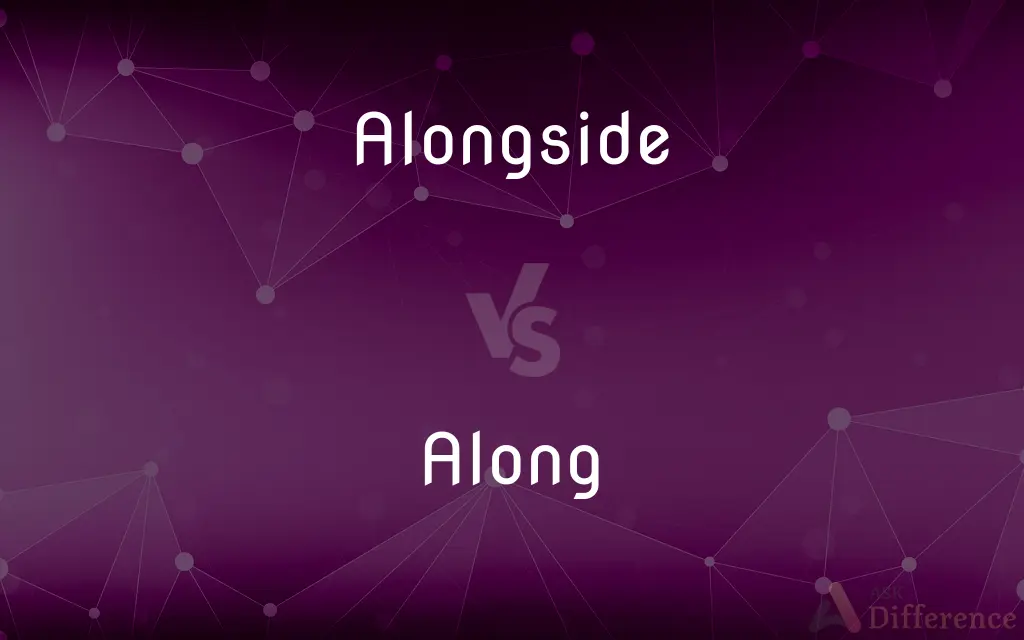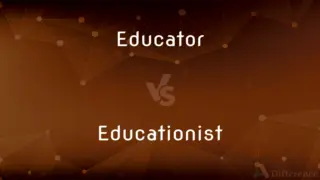Alongside vs. Along — What's the Difference?
By Maham Liaqat & Urooj Arif — Updated on March 13, 2024
"Alongside" refers to being next to or together with something, emphasizing side-by-side placement, whereas "along" indicates movement or extension through or across an area.

Difference Between Alongside and Along
Table of Contents
ADVERTISEMENT
Key Differences
Alongside is used to describe a position that is next to or at the side of something else, often implying a close association or parallel arrangement. On the other hand, along denotes a linear movement or presence that stretches across the length of something, focusing on the direction rather than a specific side-by-side placement.
When emphasizing companionship or support, "alongside" is preferred, suggesting partnership or equality, such as in a collaborative effort. In contrast, "along" is used to describe progression or distribution in a path or space, highlighting the aspect of movement or extension without implying companionship.
In the context of physical proximity, "alongside" can suggest being in direct contact or within a very close range, indicating a more intimate or connected placement. Conversely, "along" can refer to a broader, more general positioning that follows the length of something, without necessarily being close or directly adjacent.
"Alongside" is often used when two or more entities are involved, highlighting their parallel positions or joint participation. "Along," however, can be used when referring to a single entity moving through or being situated in a line along something else, focusing on the linear aspect rather than relational positioning.
The preposition "alongside" can indicate equal standing or mutual involvement in a situation or task, whereas "along" might imply a singular journey or the existence of something in a continuous line, without the connotation of partnership or equality.
ADVERTISEMENT
Comparison Chart
Meaning
Next to, in close proximity or parallel arrangement
Through or across the length of something
Usage
To denote side-by-side positioning or partnership
To indicate movement or extension along a path
Connotation
Partnership, equality, direct contact
Movement, progression, linear extension
Typical Context
When discussing relationships or direct comparisons
Describing paths, locations, or spatial distributions
Example
"The ship sailed alongside the dock."
"We walked along the river."
Compare with Definitions
Alongside
Equally or jointly participating.
The new recruit trained alongside the veterans.
Along
Throughout the extent of.
Shops are scattered along the boulevard.
Alongside
Supporting or accompanying.
The guidelines were developed alongside the policy.
Along
In the course of.
Along the journey. we encountered various obstacles.
Alongside
In company or association with.
She worked alongside experts in the field.
Along
Moving forward on a path or route.
We strolled along the beach at sunset.
Alongside
Positioned next to or together with.
The police car pulled up alongside ours.
Along
At a particular point within something.
You'll find the café along this street.
Alongside
Parallel to something.
The bike lane runs alongside the main road.
Along
In a line that follows the length of something.
Flowers were planted along the pathway.
Alongside
Along, near, at, or to the side
Stood with a bodyguard alongside.
Drove up alongside.
Along
Over the length of
Walked along the path.
Alongside
By the side of; side by side with
The boat lay alongside the pier.
Along
On a line or course parallel and close to; continuously beside
Rowed along the shore.
The trees along the avenue.
Alongside
Along the side; by the side; side by side; abreast.
Ahoy! Bring your boat alongside.
Along
In accordance with
The committee split along party lines over the issue.
Alongside
Side by side with.
Along
Forward; onward
We drove along, admiring the view. Farther along, we passed a hitchhiker.
Alongside
Together with or at the same time.
The nurse worked alongside the doctor.
Along
As company
Bring your friend along.
Alongside
Along or by the side; side by side with; - often with of; as, bring the boat alongside; alongside of him; alongside of the tree.
Along
In accompaniment or association; together
Packed an atlas along with other books. See Usage Note at together.
Alongside
Side by side;
Anchored close aboard another ship
Along
With one; at hand
Luckily, I had my camera along. Our guests should be along soon.
Along
(Informal) Advanced to some degree
My father is getting along in years.
Along
By the length of; in a line with the length of; lengthwise next to.
Along
In a line with, with a progressive motion on; onward on; forward on.
Along
In company; together.
John played the piano and everyone sang along.
Along
Onward, forward, with progressive action.
Don't stop here. Just move along.
Along
By the length; in a line with the length; lengthwise.
Some laid along . . . on spokes of wheels are hung.
Along
In a line, or with a progressive motion; onward; forward.
We will go along by the king's highway.
He struck with his o'ertaking wings,And chased us south along.
Along
In company; together.
He to England shall along with you.
Along
By the length of, as distinguished from across.
The kine . . . went along the highway.
Along
Now heard only in the prep. phrase along of.
Along
With a forward motion;
We drove along admiring the view
The horse trotted along at a steady pace
The circus traveled on to the next city
Move along
March on
Along
In accompaniment or as a companion;
His little sister came along to the movies
I brought my camera along
Working along with his father
Along
To a more advanced state;
The work is moving along
Well along in their research
Hurrying their education along
Getting along in years
Along
In addition (usually followed by `with');
We sent them food and some clothing went along in the package
Along with the package came a bill
Consider the advantages along with the disadvantages
Along
In line with a length or direction (often followed by `by' or `beside');
Pass the word along
Ran along beside me
Cottages along by the river
Common Curiosities
What is the main difference between "alongside" and "along"?
"Alongside" denotes side-by-side proximity or partnership, while "along" describes movement or extension through or across something.
Is "alongside" only used for physical positioning?
Primarily, yes, but it can also metaphorically suggest partnership or close association in non-physical contexts.
Does "along" always imply movement?
Not always; it can also indicate a position that stretches across the length of something, whether or not movement is involved.
How do "alongside" and "along" compare in terms of spatial relationships?
"Alongside" emphasizes a closer, side-by-side relationship, while "along" refers to a broader positioning along the length of something.
Can "alongside" imply equality or partnership?
Yes, it often conveys a sense of equality, partnership, or mutual involvement.
How does "along" work in describing a journey?
It can describe the path taken during a journey, emphasizing progression through or along a specific route.
Can "along" be used without implying direction?
Yes, "along" can simply denote a position or presence along something without specifying direction.
Can "alongside" suggest competition?
While it might imply proximity in a competitive sense, it more commonly suggests partnership or cooperation.
Can "alongside" and "along" be used interchangeably?
While there might be contexts where their use overlaps, they are not generally interchangeable due to their distinct connotations of proximity and movement.
Is "alongside" used in nautical contexts?
Yes, it's commonly used to describe ships or boats that are next to each other or next to a wharf.
How does "alongside" function in team contexts?
It emphasizes collaboration and side-by-side work or support within a team.
Are there expressions exclusive to "along" or "alongside"?
Yes, certain phrases and idioms uniquely fit one or the other based on their specific meanings.
Can "alongside" be used to describe emotional or intellectual support?
Yes, it can metaphorically describe support or collaboration in emotional, intellectual, or professional contexts.
How do "alongside" and "along" contribute to sentence clarity?
They help clarify spatial relationships, movement, and associations between subjects and objects.
What is a common use of "along" in storytelling?
It's frequently used to describe characters' movements within a setting or progression through a plot.
Share Your Discovery

Previous Comparison
Twofold vs. Double
Next Comparison
Educator vs. EducationistAuthor Spotlight
Written by
Maham LiaqatCo-written by
Urooj ArifUrooj is a skilled content writer at Ask Difference, known for her exceptional ability to simplify complex topics into engaging and informative content. With a passion for research and a flair for clear, concise writing, she consistently delivers articles that resonate with our diverse audience.














































